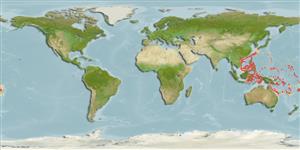Malacostraca |
Decapoda |
Penaeidae
Environment: milieu / climate zone / depth range / distribution range
Ecology
Benthic; depth range 134 - 660 m (Ref. 99823). Tropical
Western Central Pacific: Indonesia, New Caledonia and the Philippines.
Length at first maturity / Size / Weight / Age
Maturity: Lm ? range ? - ? cm
On mud or sand (Ref. 99823).
Life cycle and mating behavior
Maturity | Reproduction | Spawning | Eggs | Fecundity | Larvae
Members of the order Decapoda are mostly gonochoric. Mating behavior: Precopulatory courtship ritual is common (through olfactory and tactile cues); usually indirect sperm transfer.
Pérez Farfante, I. and B. Kensley 1997 Penaeoid and Sergestoid shrimps and prawns of the world: keys and diagnoses for the families and genera. Mémoires du Muséum National d'Histoire Naturelle 175:1-233. (Ref. 75620)
IUCN Red List Status
(Ref. 130435: Version 2025-1)
CITES status (Ref. 108899)
Not Evaluated
Not Evaluated
Threat to humans
Human uses
| FishSource |
Tools
More information
Trophic EcologyFood items (preys)
Diet composition
Food consumption
Predators
Population dynamicsGrowthMax. ages / sizesLength-weight rel.Length-length rel.Length-frequenciesMass conversionAbundance Life cycleReproductionMaturityFecunditySpawningEggsEgg developmentLarvae PhysiologyOxygen consumption
Human RelatedStamps, coins, misc.
Internet sources
Estimates based on models
Preferred temperature
(Ref.
115969): 9.3 - 19.5, mean 13.4 (based on 101 cells).
Resilience
High, minimum population doubling time less than 15 months (K=1.67-2.17).
